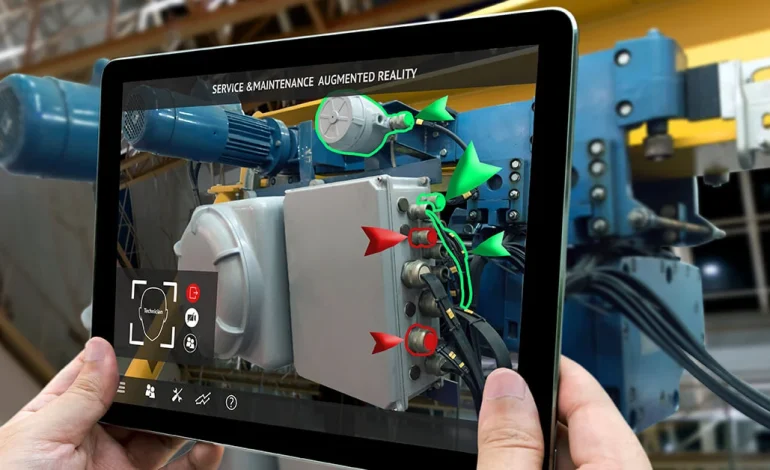Improving Safety Training in High-Risk Industries with AR

The importance of safety training for employees in high-risk industries cannot be overstated. Companies can now train their employees in safety procedures more successfully, thanks to augmented reality (AR). Companies can provide a more immersive and engaging experience that will help employees better understand the risks associated with their profession and how to work safely by enhancing safety training with augmented reality. In this blog post, we’ll look at how augmented reality is revolutionizing safety training in high-risk industries.
The requirement for better safety education in high-risk industries
Construction, manufacturing, and other high-risk sectors require AR to enhance safety training. These professions are regarded as high-risk due to the use of heavy equipment, dangerous chemicals, and working at heights, among other things. As a result, they are more likely to have mishaps, suffer injuries, or even die.
Traditionally, classroom instruction and on-the-job training have been used to deliver safety training in these industries. However, these approaches have some drawbacks and dangers because they can be time-consuming, expensive, and hazardous for students who might be put in perilous situations without adequate protection.
Augmented reality (AR) has emerged in this setting as a promising solution that can offer risk-free and realistic training experiences, enhancing competence and safety. AR creates an immersive and interactive learning environment that can simulate various scenarios, dangers, and emergencies by superimposing digital data and visualizations onto actual objects.
These topics are perfect for industries that struggle with safety training issues because each delves into a particular subject and suggests AR as a potential solution. In the following sections, we will examine the drawbacks of conventional safety training techniques and the potential of AR-based safety training.
Traditional safety training methods face difficulties.
As problems with conventional safety training methods continue to emerge, improving safety training in high-risk industries with augmented reality is becoming increasingly crucial. Practical safety training is vital due to the high risk and strict safety regulations in sectors like construction and manufacturing. The limitations of conventional safety training techniques, such as classroom instruction and on-the-job training, can lead to effective and efficient training. Time, financial, and risk restrictions are a few examples of these restrictions. AR-based safety training addresses these issues by offering risk-free and realistic training experiences by enhancing competence and safety. These topics are perfect for enhancing safety training in high-risk industries because each delves into a particular issue and suggests AR as a potential solution.
Augmented reality’s potential for safety training
Using AR to enhance safety training in high-risk industries can have many advantages over conventional safety training techniques. The risks and restrictions in sectors like construction or manufacturing are problems with traditional safety training. Because the risks in these industries are high, safety training must be conducted without running the risk of harm or destruction. However, delivering effective training scenarios that accurately simulate risky situations without putting employees in danger can be challenging.
These drawbacks could be overcome, and augmented reality could offer risk-free but realistic training scenarios. Without putting employees at risk, an AR headset, for instance, could simulate working at great heights or close to powerful machinery. Additionally, it can offer feedback on safety procedures, allowing staff members to improve their methods while remaining safe.
Due to the realistic, interactive, and immersive training experiences that AR-based safety training offers, worker safety can be significantly increased. These learning opportunities can help employees avoid dangerous situations, teach them about their errors, and ultimately lower the number of accidents and injuries in high-risk industries.
Advantages of safety training based on AR

Using AR to enhance safety training in high-risk industries can have several advantages:
- AR offers a risk-free training environment, which is crucial for sectors like manufacturing or construction. This means that students can encounter risky situations without actually being in danger.
- AR-based training enables interactive, realistic simulations to improve learning and retention of safety procedures. No matter where they are located or their skill level, all trainees receive consistent experience through this type of training.
- AR can lessen the time and expense required for conventional safety training techniques, making it a practical and efficient remedy for the problems with risks and restrictions in traditional safety training in high-risk industries.
Examples of effective safety training programs based on AR
There are many instances of businesses using AR-based safety training programs to great success. For example, Mortenson Construction has used augmented reality (AR) technology to give its staff members interactive safety training. In their “Safety First” training program, AR simulates potentially dangerous situations so that staff members can practice responding in a safe setting.
Another illustration is GE’s use of augmented reality to train wind turbine technicians. Technicians can gain experience in a realistic but secure environment by using AR. It practice troubleshooting scenarios on a virtual wind turbine. As a result, efficiency has increased, and downtime and accidents have decreased.
Similarly, Siemens has created a training program that uses augmented reality to simulate several risky situations. In the program’s risk-free training environment, employees can practice handling emergencies like gas leaks or fires.
These instances show how AR-based safety training can potentially deliver lifelike, risk-free training scenarios. Companies can increase employee safety while boosting productivity and decreasing downtime by overcoming. The drawbacks of risks and restrictions in conventional safety training methods.
Removing obstacles to adoption
Despite the advantages of AR-based safety training, adoption still faces obstacles. The risks and restrictions associated with safety training in sectors. Like construction or manufacturing are one of the major pain points. These fields frequently involve high levels of risk and potential dangers that could cause fatalities or serious injuries.
It is crucial to discuss how AR can offer risk-free and realistic training experiences to overcome this obstacle. Through AR, students can study safety guidelines and procedures in a simulated setting that simulates real-world situations.
The expense of implementing AR-based safety training presents another barrier to adoption. For businesses in high-risk industries, the advantages of improved safety and decreased liability make the investment worthwhile.
Workers accustomed to conventional training techniques may also be resistant to change. Companies can address this by offering rewards and chances for employee feedback to promote engagement with the new training technology.
Overall, industries can increase the efficiency of safety training. So ultimately lower the number of workplace accidents and injuries by addressing these barriers. It also promots the advantages of AR-based safety training.





